Target CPM (Cost per mille) adjusts open auction pricing rules to improve performance and optimize your floor prices.
While traditional CPM models often create a difficult balancing act for publishers. Setting floor prices too high can limit the number of advertisers willing to bid on your inventory, resulting in lower fill rates. Setting them too low could mean undervaluing your ad space and leaving potential revenue on the table.
Target CPM offers a more flexible and intelligent solution with several benefits:
- Machine Learning-Driven Optimization: Google’s robust machine learning algorithms analyze massive amounts of real-time data on advertiser bids, user behavior, and market trends. This allows Target CPM to dynamically adjust floor prices in each auction to maximize the likelihood of a successful sale while still aiming to achieve your desired CPM targets.
- Increased Fill Rates: By allowing for flexibility in floor pricing, Target CPM helps you capture more potential ad impressions that may have been missed with a rigid floor price. This means more of your ad inventory gets sold, and fewer eyeballs go to waste.
- Maximized Revenue: Target CPM aims to strike the perfect balance between fill rate and CPM. Since more impressions are sold, and the system strategically pushes for higher prices when possible, the overall result is the potential for an increase in total revenue.
- Reduced Management Overhead: Target CPM takes the guesswork out of constantly monitoring and tweaking floor prices. You let Google’s algorithms handle the optimization, freeing up your time and resources to focus on other strategic areas.
Target CPM vs Hard Floors
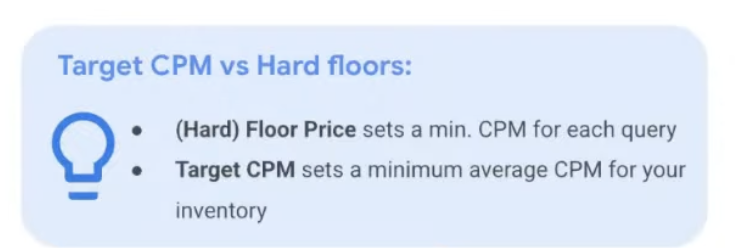
Traditionally, publishers have relied on Hard Floor Prices to establish a minimum acceptable CPM for each impression sold. This ensures a baseline level of revenue for your ad inventory. However, Hard Floor Prices can also be blunt instruments. If you set them too high, you risk excluding bids that could potentially be profitable, leading to unsold inventory.
Target CPM offers a more nuanced approach. It represents a minimum average CPM for your ad inventory.
- (Hard) Floor Price sets a minimum CPM for each query.
- Target CPM sets a minimum average CPM for your ad inventory.
- Target CPM provides an alternative way of setting a floor price that allows for increased fill rate and yield while maintaining an average minimum price for ad inventory.
- Available for any individual UPR: applies to Ad Exchange, Open Bidding, and remnant line item floors.
- Blocks and Reservation prices are always respected, meaning that when Target CPM allows non-guaranteed winners to win, it is always the most valuable impression.
How Target CPM drives Value?
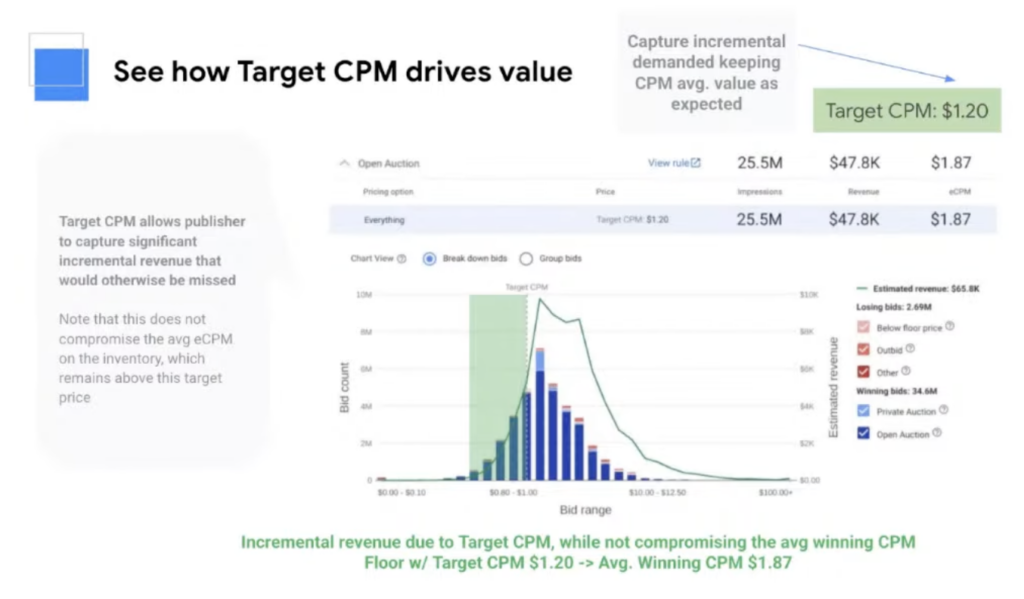
From the above image we can see how Target CPM drives value. This is because target CPM allows publishers to capture significant incremental revenue that would otherwise be missed.
The text in the image says that Target CPM allows publishers to capture significant incremental revenue that would otherwise be missed. This is because Target CPM sets a floor price that is lower than the average winning CPM. This means that publishers can still sell impressions to advertisers who are willing to bid below the average winning CPM, but higher than the target CPM. This can help to increase fill rates and overall revenue.
Here are some of the key benefits of using Target CPM:
- Increased fill rates: By setting a lower floor price, Target CPM can help to increase fill rates by capturing bids that would otherwise be lost.
- Increased revenue: By capturing more bids, Target CPM can help to increase overall revenue.
- Maintains a high average eCPM: Target CPM does not compromise the average eCPM. The average eCPM remains above the target price.
Overall, Target CPM is a valuable tool that can help publishers increase fill rates and revenue without sacrificing the average eCPM.
Target CPM: A Solid Revenue Booster
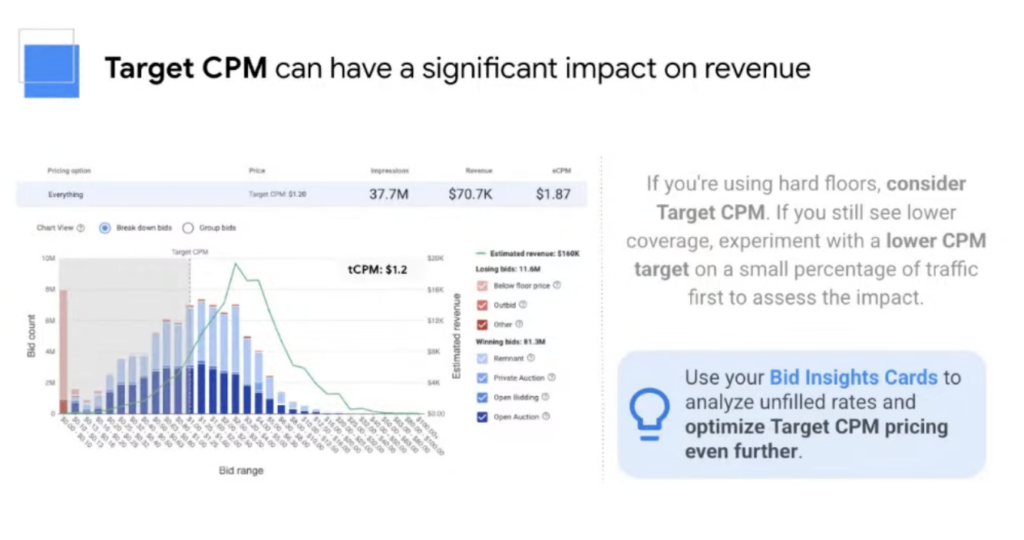
If you’re using hard floors, consider Target CPM. If set too high, hard floors can lead to lost revenue. Target CPM’s dynamic adjustments open possibilities for capturing valuable bids that might fall just under your hard floor. The increased fill rate facilitated by Target CPM, coupled with intelligent floor price adjustments, often results in higher overall revenue.
If you still see lower coverage, experiment with a lower CPM target on a small percentage of traffic first to assess the impact.
Here’s a strategic approach:
- Small-Scale Testing: Begin by applying the lower CPM target to a small portion of your traffic (e.g., 5-10%). This lets you assess the impact on fill rate and revenue without risking a drastic change across your entire inventory.
- Data-Driven Decisions: Monitor your performance metrics closely during the test period. Compare the fill rate, overall CPM, and revenue to your baseline.
- Iterate and Expand: If results are positive, gradually expand the lower CPM target to a larger portion of your traffic. Continuously track your performance to fine-tune your Target CPM strategy.
Benefits of Target CPM
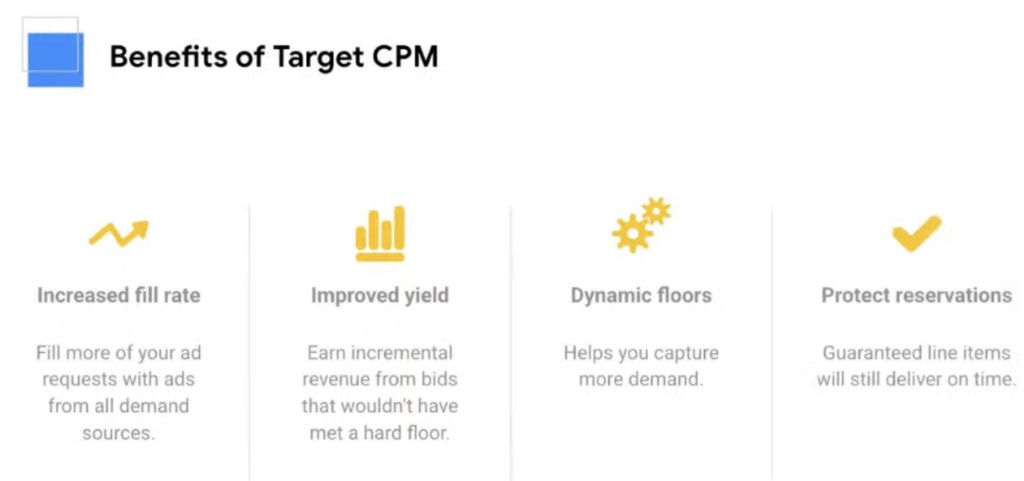
Target CPM empowers publishers to intelligently automate their floor pricing, aiming for increased revenue without sacrificing CPM goals. By relinquishing some control to Google’s machine learning, you can focus on other aspects of your ad monetization strategy while potentially generating a significant uplift in revenue.
- Increased Fill Rate: Target CPM’s ability to dynamically lower floor prices allows you to sell ad impressions that may have been unsold with a rigid pricing structure. This increased flexibility translates into a higher fill rate and less wasted ad space.
- Improved Yield: By increasing your fill rate and capturing more demand, you naturally boost the total revenue potential of your ad inventory. Target CPM, when used strategically, helps you optimize the balance between the number of ads served and the price you receive for them.
- Dynamic Floors(Helps you capture more demand): Google’s advanced algorithms analyze historical data, market trends, and real-time bidding signals to adjust floor prices in each auction. This intelligence allows you to secure bids that might otherwise have been lost if your floor were too high, resulting in increased revenue.
- Protect Reservations: Target CPM is designed to work in harmony with your existing reservation-based campaigns (guaranteed line items). When a reservation has priority, Target CPM respects this, ensuring your committed inventory is delivered as promised while also optimizing unreserved space.
Best Practices
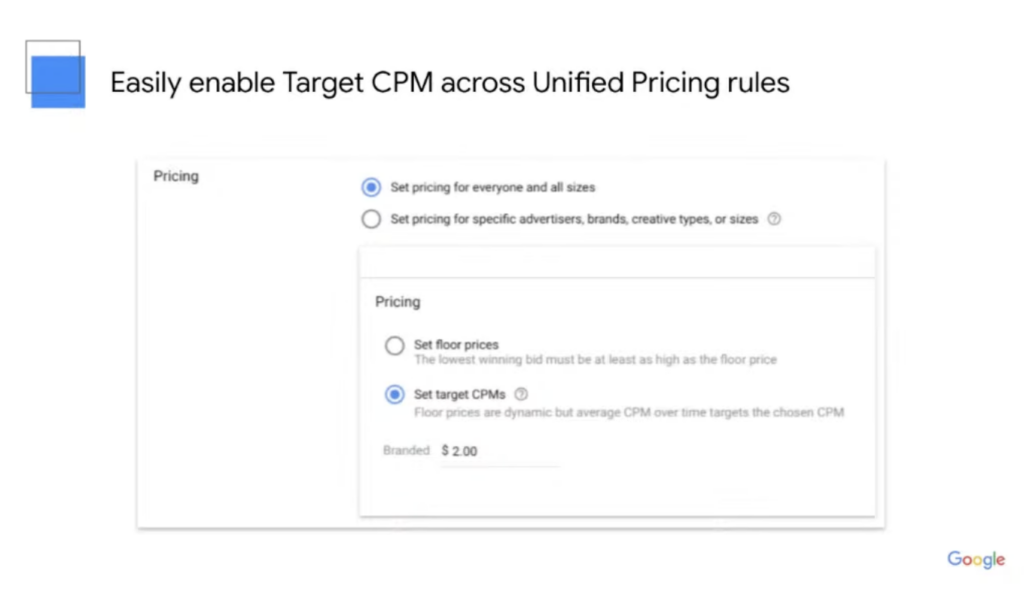
-Avoid increasing the rule price as the rule is changed from a floor to a target CPM if you would like to improve yield.
-Allow 2-4 weeks when testing to see changes.
-Fine-tune your targeting criteria for better results. Consider factors like device type, geography, dayparting (time of day), and specific ad units when setting up Target CPM rules. This allows for more tailored floor price adjustments.
-Analyze your past performance data to identify ad inventory segments that historically underperform with your usual floor price approach. Target CPM could potentially unlock more revenue for these segments.
-Seasonal Fluctuations: Account for seasonal trends in advertising demand. You may need to adjust your Target CPMs during peak seasons or periods of low activity.
Case Study Analysis
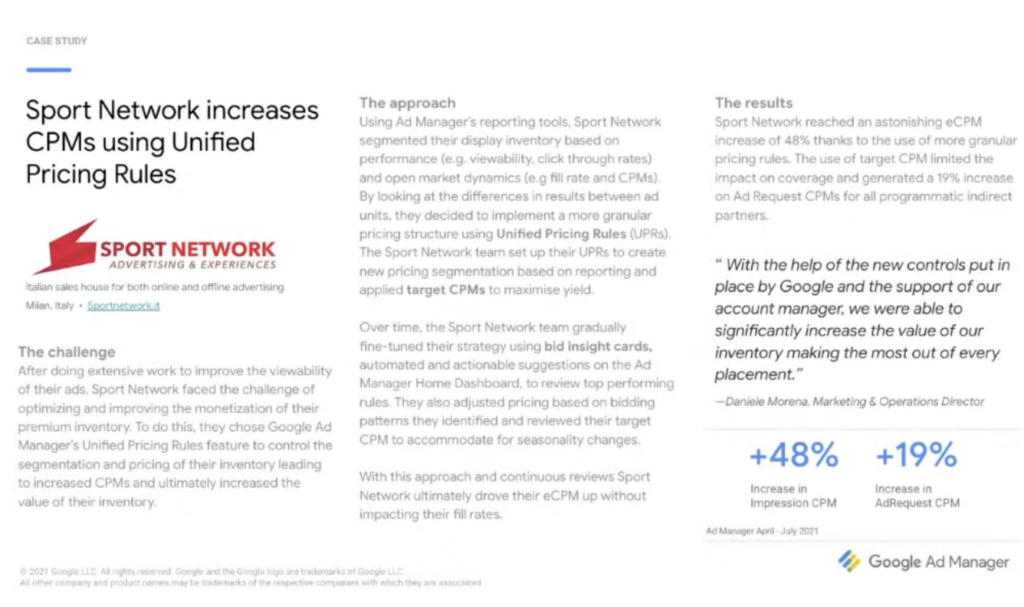
The case study below highlights how Sport Network, an Italian sales house for online and offline advertising, increased their eCPM (effective cost per mille) by 48% through using Google Ad Manager’s Unified Pricing Rules (UPRs) with a target CPM strategy.
Here’s a breakdown of the key takeaways from the case study:
- The Challenge: Sport Network wanted to improve the monetization of their premium ad inventory after successfully optimizing viewability. They needed a solution to optimize pricing and maximize yield without impacting fill rates.
- The Solution: Sport Network implemented Google Ad Manager’s UPRs with a target CPM strategy. This allowed them to set pricing rules based on various factors like viewability, click-through rates, and open market dynamics.
- The Results: By using target CPM, Sport Network achieved a significant increase in eCPM (48%) while maintaining fill rates. They also saw a 19% lift in ad request CPM for all programmatic indirect partners. This indicates that they were able to capture more bids and potentially secure higher bids through the more granular approach offered by target CPM.
The case study highlights the potential benefits of target CPM for publishers:
- Increased Revenue: By capturing more bids and potentially achieving higher CPMs, target CPM can lead to a significant uplift in overall revenue.
- Improved Efficiency: Target CPM automates the process of adjusting floor prices, freeing up publisher time and resources.
- Optimized Yield: The ability to set pricing based on various factors allows publishers to find the sweet spot between fill rates and CPMs, maximizing the return on their ad inventory.
source https://www.monetizemore.com/blog/target-cpm/




0 Comments